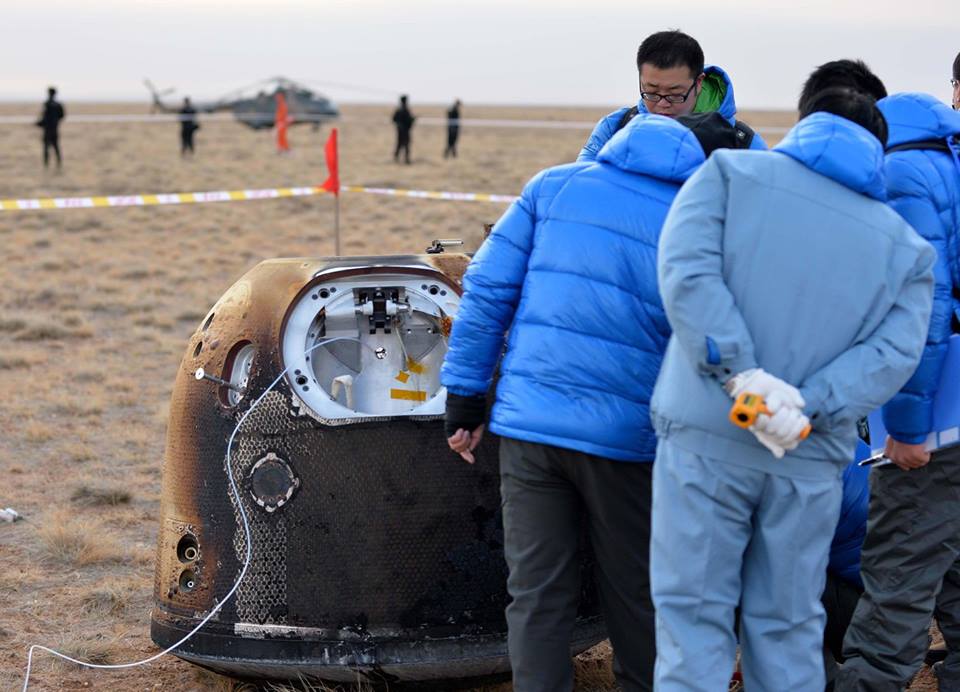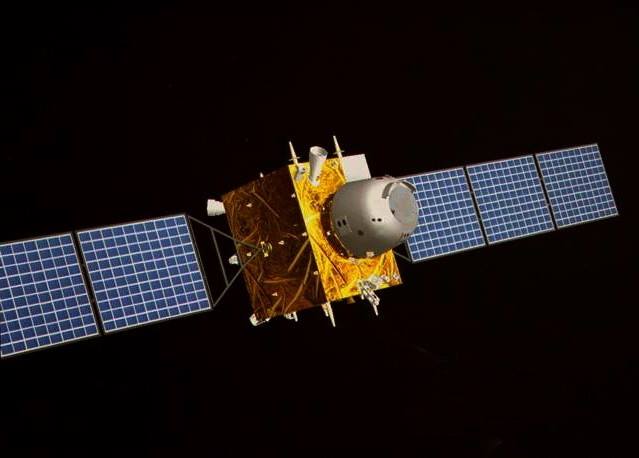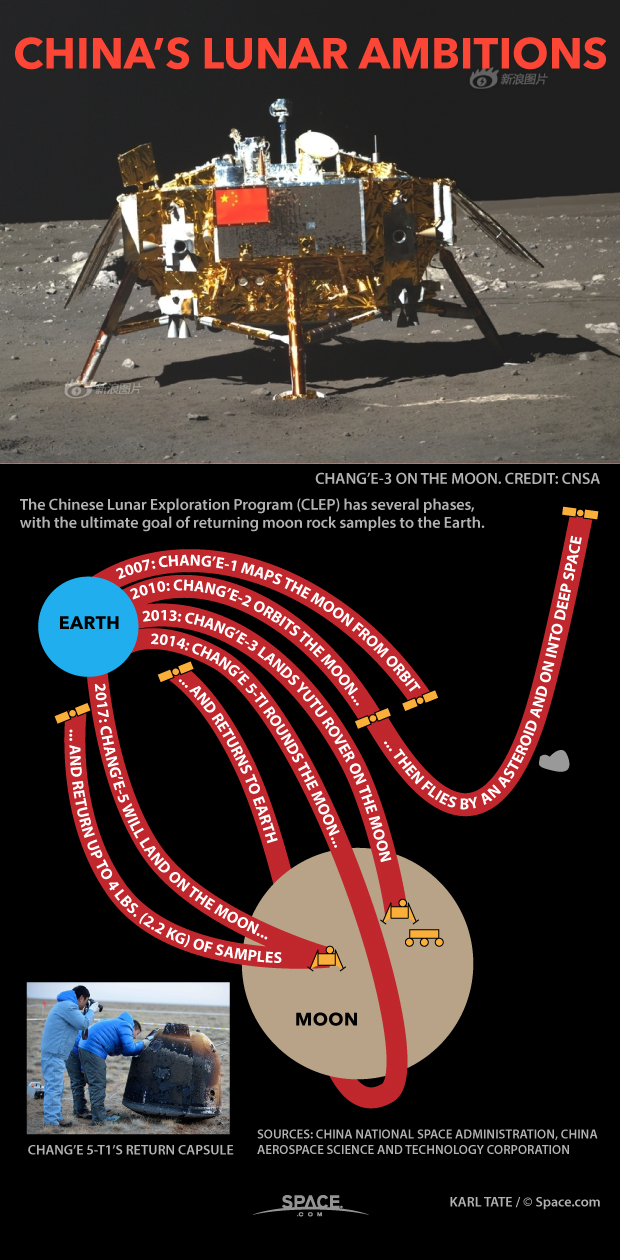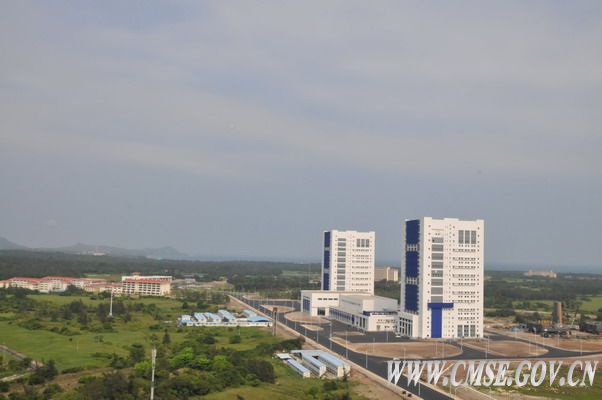
China's 1st Round-Trip Moon Shot Sets Stage for Bigger Lunar Feats

China has no plans to rest on its laurels after its historic moon mission touched down successfully back on Earth late last week.
A Chinese test capsule parachuted safely to Earth on Friday (Oct. 31, Nov. 1 local China time) after being launched on a slingshot journey around the moon eight days earlier, capping the world's first mission to Earth's nearest neighbor and back in nearly 40 years. China became the third nation to accomplish the feat, after the former Soviet Union and the United States.
Up next for China's multi-step lunar exploration program is Chang'e 4. While details of that mission are sketchy, it is expected to be the country's second lunar lander and rover. Chang'e 4 will also test hardware and procedural techniques useful for the Chang'e 5 sample-return mission scheduled for 2017. [China's 1st Round-trip Moon Shot in Pictures]

China's lunar ambitions are divided into three key stages: orbiting the moon, landing on the lunar surface and returning collected moon specimens to Earth.
China's Chang'e 1 and Chang'e 2 missions took place in 2007 and 2010, respectively, capping the moon-orbit phase of the three-step program. The second phase saw Chang'e 3 soft-land on the moon and dispatch the Yutu moon rover in December 2013.
Trial by fire

A Long March-3C rocket launched the latest mission, unofficially dubbed "Chang'e 5 T1," on Oct. 23. The main goal was to send a test capsule (nicknamed "Xiaofei" on Chinese social networks) into Earth's atmosphere at high speed to evaluate various technologies and techniques for the ambitious Chang'e 5 project of 2017.
Xiaofei performed a "skip" re-entry process, with the returning capsule hot-footing its way into Earth's atmosphere at a blistering velocity of nearly 25,000 mph (40,000 km/h).
Get the Space.com Newsletter
Breaking space news, the latest updates on rocket launches, skywatching events and more!
To reduce speed, the craft bounced off the edge of the atmosphere, before re-entering again and parachuting into a pre-selected landing location in north China's Inner Mongolia Autonomous Region.
The skip process is akin to skipping a stone across water, and can shorten the "braking distance" for a returning capsule, according to Zhou Jianliang, chief engineer with the Beijing Aerospace Command and Control Center.
"Really, this is like braking a car," Zhou told Xinhua, the state-run Chinese news agency. "The faster you drive, the longer the distance you need to bring the car to a complete stop."
Challenges ahead
China will duplicate its mastery of the skip re-entry technique in the Chang'e 5 mission, with its return sample capsule loaded with 4.4 lbs. (2 kilograms) of moon specimens.
Chang'e 5 will face many challenges in addition to high-speed re-entry, Wu Weiren, chief designer of China's lunar exploration program, also told Xinhua.
Major technological challenges for that mission center on surface sampling, rocketing the goods off from the moon, then rendezvousing and linking up with a return module in lunar orbit for the journey back to Earth, Wu said.
New launch complex
When Chang'e 5 departs for the moon, it will do so atop a Long March 5 rocket from China's new launch complex: the Wenchang Satellite Launch Center in Hainan province.
Construction of that facility began in 2009, and it will soon become operational, Chinese officials say.

The center is designed to handle China's next-generation rockets, the launching of large space station modules and deep-space missions. It is built to loft the Long March 5, the country's most powerful booster, which is now in development. [The World's Tallest Rockets]
The Long March 5 will make its maiden flight from the new center next year, said Qi Faren, former chief designer of the Shenzhou spaceships.
The Wenchang launch site is situated on the northeast coast of Hainan Island, about 37 miles (60 kilometers) from Haikou, the provincial capital. The center is the country's first coastal satellite launch base.
The Hainan Island site adds to a threesome of already-operating Chinese launch areas: the heavily used Jiuquan Satellite Launch Center in the Gobi Desert; Taiyuan in Shanxi province; and a facility in Xichang, Sichuan province.
Putting boots on the moon
China's growing lunar-exploration prowess is just a glimpse of what's likely to come in future years, experts say.
For one, China appears ready to attempt its sample-return mission, said Paul Spudis, a planetary geology and remote sensing expert at the Lunar and Planetary Institute in Houston. But there's more, he said.
"In effect, China now has positive practical experience with all of the elements of a human mission to the moon," Spudis told Space.com. "There is no doubt in my mind that is their objective, and the only question now is when, not if."
Spudis added, "And to the brainless twits who might comment that they [China] are only doing something that we [the United States] have already done, I will simply note that no one at the current incarnation of NASA has done it."
Leonard David has been reporting on the space industry for more than five decades. He is former director of research for the National Commission on Space and is co-author of Buzz Aldrin's 2013 book "Mission to Mars – My Vision for Space Exploration" published by National Geographic. Follow us @Spacedotcom, Facebook or Google+. Originally published on Space.com.
Join our Space Forums to keep talking space on the latest missions, night sky and more! And if you have a news tip, correction or comment, let us know at: community@space.com.

Leonard David is an award-winning space journalist who has been reporting on space activities for more than 50 years. Currently writing as Space.com's Space Insider Columnist among his other projects, Leonard has authored numerous books on space exploration, Mars missions and more, with his latest being "Moon Rush: The New Space Race" published in 2019 by National Geographic. He also wrote "Mars: Our Future on the Red Planet" released in 2016 by National Geographic. Leonard has served as a correspondent for SpaceNews, Scientific American and Aerospace America for the AIAA. He has received many awards, including the first Ordway Award for Sustained Excellence in Spaceflight History in 2015 at the AAS Wernher von Braun Memorial Symposium. You can find out Leonard's latest project at his website and on Twitter.









